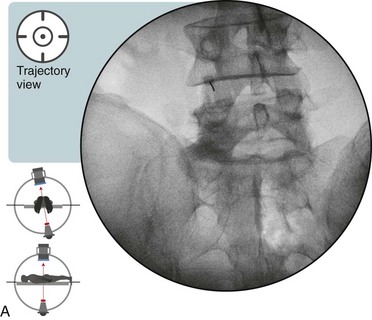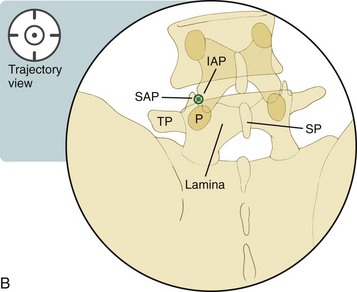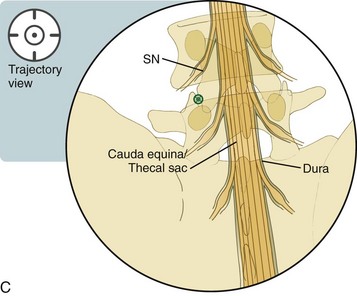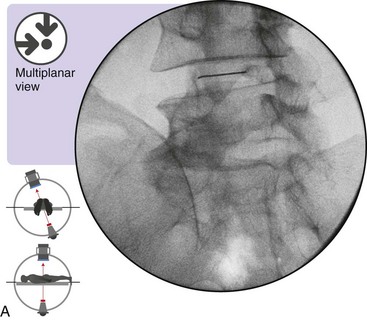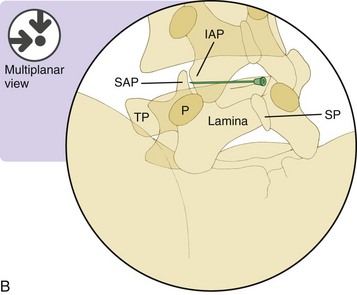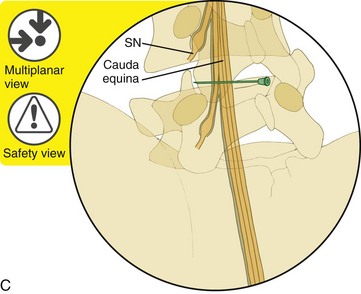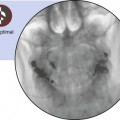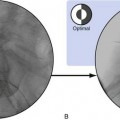Chapter 13 Lumbar Zygapophysial Joint Intraarticular Joint Injection, Posterior Approach
Note: Please see page ii for a list of anatomical terms/abbreviations used in this book.
The lumbar zygapophysial (facet) joints were first recognized as a potential source of spine pain by Goldthwait in 1911.1 The term facet syndrome was first used by Ghormley in 1933.2 Recent literature supports that the lumbar zygapophysial joints have a pain prevalence of 15% to 45% among individuals with chronic low back pain.3–5 Lumbar zygapophysial-joint–mediated pain cannot be absolutely diagnosed by history, clinical examination, or radiographic imaging.6–11 The intraarticular injection can potentially provide diagnostic and therapeutic benefits. Depending on the patient’s clinical assessment, these injections can be performed unilaterally or bilaterally.
 Trajectory View
Trajectory View
Confirm the level (with the anteroposterior view).
Oblique the fluoroscope’s image intensifier ipsilaterally (Figure 13–1).
 If the joint is sagittally oriented, oblique angulation of the fluoroscope may not be necessary.
If the joint is sagittally oriented, oblique angulation of the fluoroscope may not be necessary.
 Correlation with magnetic resonance images or computed tomography axial images may be helpful for estimating the optimal oblique angle at which the joint may be entered.
Correlation with magnetic resonance images or computed tomography axial images may be helpful for estimating the optimal oblique angle at which the joint may be entered.
 The target needle destination is at the middle to upper half of the joint and toward the medial border of the joint-space silhouette. The target can be the superior or inferior recess too, which is discussed later in the chapter.
The target needle destination is at the middle to upper half of the joint and toward the medial border of the joint-space silhouette. The target can be the superior or inferior recess too, which is discussed later in the chapter.
 Oblique ipsilaterally until the joint-space silhouette can be identified, and then decrease the angulation until the silhouette begins to fade away. Usually the oblique angle is 5–10 degrees.
Oblique ipsilaterally until the joint-space silhouette can be identified, and then decrease the angulation until the silhouette begins to fade away. Usually the oblique angle is 5–10 degrees.
 This optimizes access to the medial border of the joint by making use of a more medial-to-lateral entry angle.
This optimizes access to the medial border of the joint by making use of a more medial-to-lateral entry angle.Tilt the fluoroscope cephalad or caudad, if needed.
 Little tilt is needed. Optimize entry into the joint.
Little tilt is needed. Optimize entry into the joint.
 At the L5-S1 level, the iliac crest may be superimposed over the zygapophysial joint. Cephalad tilt may be required to optimize the trajectory view.
At the L5-S1 level, the iliac crest may be superimposed over the zygapophysial joint. Cephalad tilt may be required to optimize the trajectory view.
 In the scoliotic spine, cephalad or caudal tilt may be required to better visualize the vertebral level and respective zygapophysial joint of interest.
In the scoliotic spine, cephalad or caudal tilt may be required to better visualize the vertebral level and respective zygapophysial joint of interest.
Place the needle parallel to the fluoroscopic beam.

